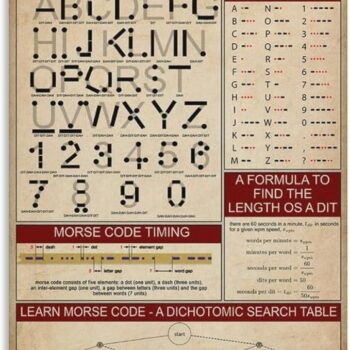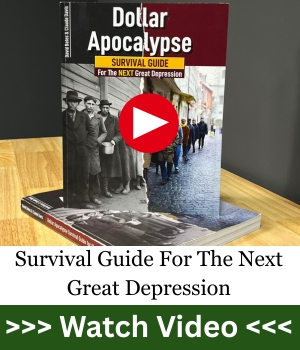When the world goes silent and modern communications fail, Morse code still gets through. It’s one of the most reliable forms of communication ever invented, and it doesn’t need electricity, cell towers, or the internet to work. Whether you’re signaling for help with a flashlight or tapping on a wall, Morse code has saved lives and carried messages through war zones, wilderness, and disaster-stricken areas. Here’s what every prepper should know about this time-tested skill.
Who Invented Morse Code?
Morse code is named after Samuel Morse, an American inventor and painter. Along with Alfred Vail, Morse developed the code in the early 1830s as a way to transmit textual information using a series of electrical pulses.
While Samuel Morse gets most of the credit, Vail contributed heavily to refining the code, especially by helping assign combinations of dots and dashes (or “dits” and “dahs”) to letters based on frequency of use. That’s why common letters like “E” are shorter, making messages faster to send.
When Was Morse Code Invented?
The Morse code system was first demonstrated in 1836 and gained widespread use in the 1840s with the rise of the telegraph. The first long-distance Morse code message was sent on May 24, 1844, between Washington, D.C., and Baltimore. The message was biblical: “What hath God wrought.”
By the 1860s, Morse code had become the standard method of communication for military and commercial messages across telegraph lines.
Why Is It Important?
In today’s world of satellites and smartphones, it’s easy to overlook Morse code. But when the power goes out, EMPs hit, or you’re off-grid with no reception, Morse code still works.
It can be transmitted in multiple ways:
- Light (like flashlight or mirror flashes)
- Sound (whistles, tapping, beeps)
- Touch (tapping on walls or pipes)
You don’t need fancy gear. You just need to know the code.
For preppers, this makes it an invaluable fallback for silent, low-tech communication
Morse Code Alphabet and Numbers
Here’s a complete chart of the English alphabet and numerals in Morse code:
| Letter | Morse Code | Number | Morse Code | |
|---|---|---|---|---|
| A | .- | 0 | —– | |
| B | -… | 1 | .—- | |
| C | -.-. | 2 | ..— | |
| D | -.. | 3 | …– | |
| E | . | 4 | ….- | |
| F | ..-. | 5 | ….. | |
| G | –. | 6 | -…. | |
| H | …. | 7 | –… | |
| I | .. | 8 | —.. | |
| J | .— | 9 | —-. | |
| K | -.- | |||
| L | .-.. | |||
| M | — | |||
| N | -. | |||
| O | — | |||
| P | .–. | |||
| Q | –.- | |||
| R | .-. | |||
| S | … | |||
| T | – | |||
| U | ..- | |||
| V | …- | |||
| W | .– | |||
| X | -..- | |||
| Y | -.– | |||
| Z | –.. |
Morse Code Punctuation
 Though not as commonly used, Morse code includes some punctuation marks.
Though not as commonly used, Morse code includes some punctuation marks.
Here are a few:
- Period (.) = .-.-.-
- Comma (,) = –..–
- Question mark (?) = ..–..
- Apostrophe (‘) = .—-.
- Slash (/) = -..-.
- Colon (:) = —…
- Semicolon (;) = -.-.-.
- Hyphen (-) = -….-
- Parentheses () = -.–.-
- Equals (=) = -…-
Spacing matters:
- Letters are separated by a space.
- Words are separated by a slash or a longer pause.
Example: “Food and Shelter Available”
Here’s how you would send the message “FOOD AND SHELTER AVAILABLE” in Morse code:
FOOD AND SHELTER AVAILABLE
Morse Code: ..-. — — -.. / .- -. -.. / … …. . .-.. – . .-. / .- …- .- .. .-.. .- -… .
If you’re signaling this with light, you’d flash the short and long bursts accordingly. With sound, tap or beep with the same rhythm.
How to Learn Morse Code
Learning Morse code takes practice, but it’s not hard. Start with your name, then common words, and build up. Flashlight practice is especially useful for silent communication.
Many apps and online tools can help with learning, but for grid-down training, flashcards and printed charts are best.
How To Memorize Morse Code Faster
Learning Morse code can feel overwhelming at first, but with the right techniques, you can commit it to memory much faster than you might expect. Here are some time-tested methods to speed up the process:
1. Use Mnemonics:
Assign sounds or phrases to each character. For example, the letter “A” (·–) can be remembered as “a-pple pie,” where “a” is the dot and “pie” is the dash. It sounds silly, but associating letters with rhythmic phrases helps lock them into memory.
2. Start With the Most Common Letters:
Focus first on the letters that appear most often in English (E, T, A, O, I, N, S, H, R). Mastering these gives you quicker wins and makes decoding real sentences easier early on.
3. Use Audio Training:
Since Morse code is designed to be heard, not just seen, listening to the tones is essential. Apps and websites like LCWO.net let you practice hearing Morse at realistic speeds. Aim to recognize whole letters by their sound rather than counting dots and dashes.
4. Practice With Flashcards:
Whether you use physical cards or a flashcard app, regular short sessions of review are more effective than long cram sessions. Try the spaced repetition method for best results.
5. Try the Farnsworth Method:
This technique speeds up the dots and dashes but adds space between letters and words. It helps train your ear to hear characters at full speed without getting overwhelmed.
6. Use Copywork:
Take short phrases and copy them in Morse code by hand or tap them out. Repetition reinforces pattern recognition and builds muscle memory.
7. Make It a Game:
Apps like Morse Mania turn learning into a challenge. The more fun you have, the more likely you’ll stick with it.
The key is consistency. Just 10–15 minutes of practice a day can help you gain fluency in a few weeks. In a survival situation where every second counts, having Morse committed to memory could be the lifeline that gets you home.
Do you know Morse code? If so, please share what you found to be the most difficult part of learning it for other preppers to learn. We can always learn from each other.
You may also like:
 10 Ways to Signal SOS in Morse Code and Other Methods
10 Ways to Signal SOS in Morse Code and Other Methods
75 Items That You Need To Stockpile Before A Collapse (Video)
HAM Radio Secret Frequencies You Should Know About





















